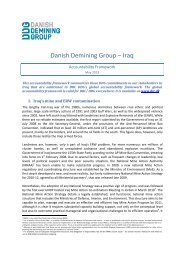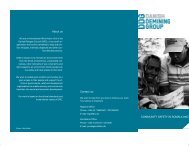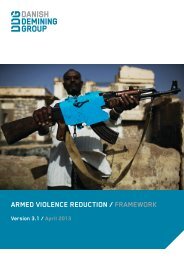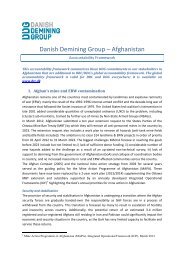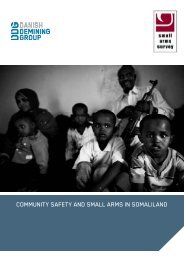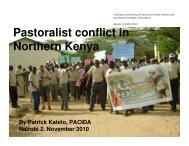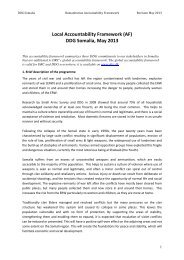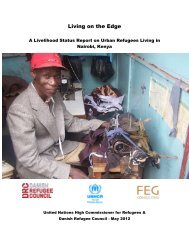Read the full report - Danish Refugee Council
Read the full report - Danish Refugee Council
Read the full report - Danish Refugee Council
You also want an ePaper? Increase the reach of your titles
YUMPU automatically turns print PDFs into web optimized ePapers that Google loves.
CASH PROGRAMME REVIEW FOR IDPs IN KABUL INFORMAL SETTLEMENTS 21unplanned expenses are met with fur<strong>the</strong>r debts, lowering in turn <strong>the</strong> ability to obtain credit on afavourable basis, entertaining a vicious circle leading to coping mechanisms damaging health,welfare, and children well-being.“We didn’t receive that much assistance last year. We just received some blankets from UNHCR,some wood and oil. But that was not enough. I <strong>the</strong>refore had to borrow money to buy wood. I amindebted for 20.000 AFS” (FGD male respondent, 40 years old).“I prefer cash- assistance because I already get food, but I need money to pay off my debts and toget my children to <strong>the</strong> hospital. I am sick myself and my daughter is also sick. I need money for ourmedical treatment” (Female participant FGD Parwan 2, 40 years old).“Our children collect old papers from <strong>the</strong> garbage and we use that for our “bukhari”, and when wedo not have enough food we borrow food from <strong>the</strong> shopkeepers and o<strong>the</strong>r members of <strong>the</strong> campuntil <strong>the</strong> wea<strong>the</strong>r gets warm and we can pay off our debts (Male FGD Charahi Qambar, 47 yearsold)Graph 3: Household’s level of debt in proportion to monthly income (%)More than ten folds17,2Up to ten folds22,4Five times as much18,4Four times as much8Three times as much10Twice as much12,8Almost equal5,6Half3,6Less than half20 5 10 15 20 253. Social vulnerability: health, housing, child protection, and securityA recent study on Challenges of IDP Protection 21 identified health, child protection and security ofIDPs’ environment as major protection concerns for IDP populations. In <strong>the</strong> context of <strong>the</strong> KIS, <strong>the</strong>present study shows that <strong>the</strong>se protection concerns cannot be taken independently from o<strong>the</strong>rfactors of vulnerability – instability of income, high dependency rates, levels of indebtedness aredeeply interrelated with protection concerns specific to inhabitants of <strong>the</strong> selected KIS. One of <strong>the</strong>main findings of this research was <strong>the</strong> central position of health in surveyed population’s concerns.Access to quality health services was mentioned to significantly mobilize <strong>the</strong>ir resources, with highlevels of debts contracted in order to access private clinics. This will <strong>the</strong>refore be <strong>the</strong> first focus ofthis sub-section.Housing, Land and Property is one of <strong>the</strong> top three protection priorities identified by <strong>the</strong> abovementionedstudy. As it cannot be directly addressed by DRC’s livelihood programmes, but cannot be21 NRC/IDMC/JIPS/SAMUEL HALL CONSULTING (2012), Challenges of IDP protection in Afghanistan: Research study on <strong>the</strong>protection of internally displaced persons in Afghanistan.



